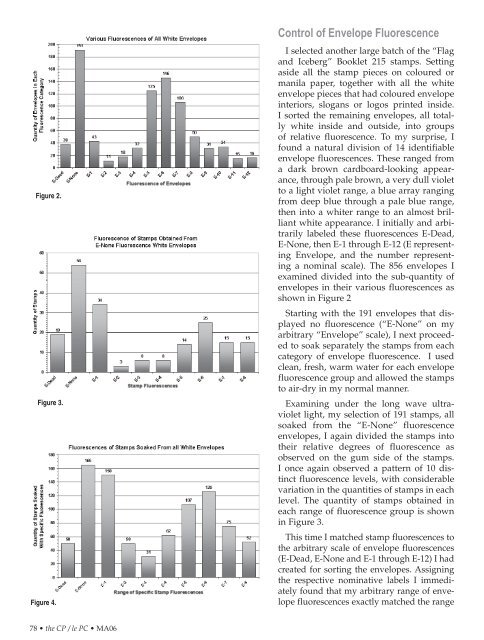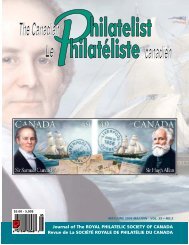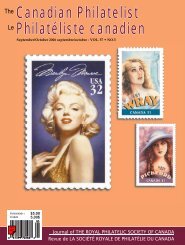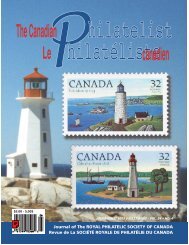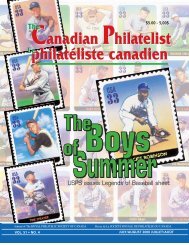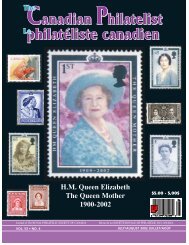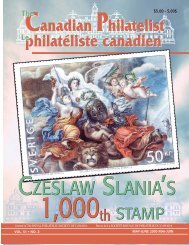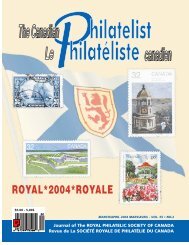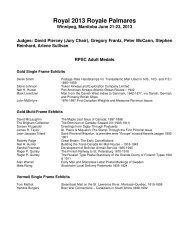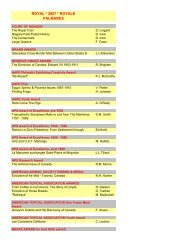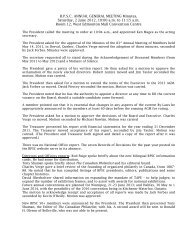Canadian Philatelist Philatéliste canadien - The Royal Philatelic ...
Canadian Philatelist Philatéliste canadien - The Royal Philatelic ...
Canadian Philatelist Philatéliste canadien - The Royal Philatelic ...
Create successful ePaper yourself
Turn your PDF publications into a flip-book with our unique Google optimized e-Paper software.
Figure 2.<br />
Figure 3.<br />
Figure 4.<br />
Control of Envelope Fluorescence<br />
I selected another large batch of the “Flag<br />
and Iceberg” Booklet 215 stamps. Setting<br />
aside all the stamp pieces on coloured or<br />
manila paper, together with all the white<br />
envelope pieces that had coloured envelope<br />
interiors, slogans or logos printed inside.<br />
I sorted the remaining envelopes, all totally<br />
white inside and outside, into groups<br />
of relative fluorescence. To my surprise, I<br />
found a natural division of 14 identifiable<br />
envelope fluorescences. <strong>The</strong>se ranged from<br />
a dark brown cardboard-looking appearance,<br />
through pale brown, a very dull violet<br />
to a light violet range, a blue array ranging<br />
from deep blue through a pale blue range,<br />
then into a whiter range to an almost brilliant<br />
white appearance. I initially and arbitrarily<br />
labeled these fluorescences E-Dead,<br />
E-None, then E-1 through E-12 (E representing<br />
Envelope, and the number representing<br />
a nominal scale). <strong>The</strong> 856 envelopes I<br />
examined divided into the sub-quantity of<br />
envelopes in their various fluorescences as<br />
shown in Figure 2<br />
Starting with the 191 envelopes that displayed<br />
no fluorescence (“E-None” on my<br />
arbitrary “Envelope” scale), I next proceeded<br />
to soak separately the stamps from each<br />
category of envelope fluorescence. I used<br />
clean, fresh, warm water for each envelope<br />
fluorescence group and allowed the stamps<br />
to air-dry in my normal manner.<br />
Examining under the long wave ultraviolet<br />
light, my selection of 191 stamps, all<br />
soaked from the “E-None” fluorescence<br />
envelopes, I again divided the stamps into<br />
their relative degrees of fluorescence as<br />
observed on the gum side of the stamps.<br />
I once again observed a pattern of 10 distinct<br />
fluorescence levels, with considerable<br />
variation in the quantities of stamps in each<br />
level. <strong>The</strong> quantity of stamps obtained in<br />
each range of fluorescence group is shown<br />
in Figure 3.<br />
This time I matched stamp fluorescences to<br />
the arbitrary scale of envelope fluorescences<br />
(E-Dead, E-None and E-1 through E-12) I had<br />
created for sorting the envelopes. Assigning<br />
the respective nominative labels I immediately<br />
found that my arbitrary range of envelope<br />
fluorescences exactly matched the range<br />
78 • the CP / le PC • MA06


